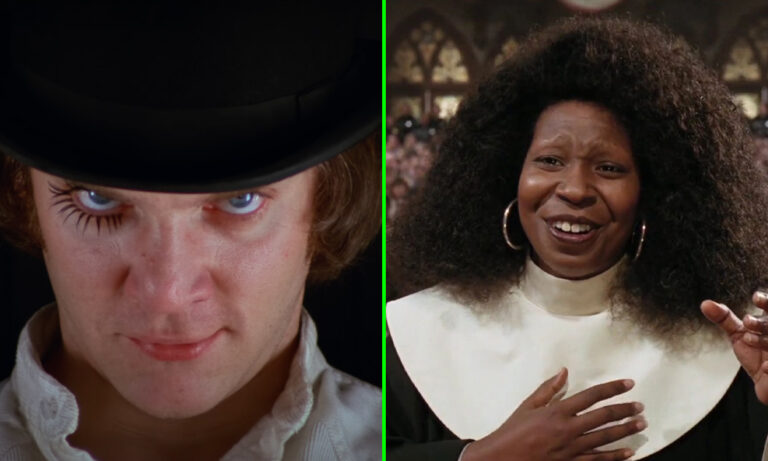From ‘A Clockwork Orange’ to ‘Sister Act’: Why some films get preserved for eternity and others don’t
Every year, the United States National Film Preservation Board (NFPB) gathers to select up to 25 films which will then be preserved in the Library of Congress in the National Film Registry (NFR), supposedly for eternity, or at least until they build a fancier library. The two primary requirements for eligibility are: the films must have notable cultural, historic or aesthetic significance and they must be at least ten years old.
There are currently 825 films within the registry. Of course, some of the picks make complete and utter sense—take Star Wars, Back to the Future or A League of Their Own for example, they’re all timeless classics. On the other hand, there are some films that have wiggled their way into this sacred time capsule that are not only incredibly questionable but also regarded by some as shockingly controversial.
1. Boys Don't Cry
Boys Don’t Cry is a 1999 film which depicts the life—and death—of Brandon Teena (born Teena Brandon), a young transgender man navigating society in rural Nebraska. Much of the plot is based on Teena’s real life—who died in 1993—and his romantic relationship with his girlfriend, Lana Tisdel.
While the divisive biographical film holds significance due to inclusion of a trans male character (portrayed by Hilary Swank), the film has also been highly criticised for the extreme and traumatic depiction of gang rape, murder and transphobia.
After the film was chosen to be preserved in the National Film Registry in 2019, The New York Times evaluated the decision, considering both the transformative ways in which the film provided crucial representation of trans men—a move that was celebrated by many LGBTQIA+ communities—but also how the brutal presentation of dehumanising violence upon the character was (and still is) incredibly painful and traumatic for many trans individuals to witness.
There is also the issue of Teena being played by Swank, a cis woman. Actor and trans man JJ Hawkins told the publication, “Of course it’s a step in the right direction—one single story about us—but also, she played a boy and she won best actress. That was the first time I realised that people who see me, see me as a girl dressed up as a boy because when they’re watching Boys Don’t Cry, they’re watching a girl dressed up as a boy.”
Other cis actors and actresses such as Jared Leto (for his role as Rayon in Dallas Buyers Club) have faced similar criticism.
It should be highlighted that there have since been a number of films and documentaries produced that reflect the positive elements of the trans experience. It’s therefore only fair that revolutionary documentaries such as Sam Feder’s Disclosure—a 2020 film that directly discusses how trans individuals have been depicted in media—be considered for preservation in the future.
2. The Birth of a Nation
The Birth of a Nation is one of—if not the—most offensive and controversial films that has been preserved as a part of this national scheme. The 1915 American silent epic drama film depicts the relationship of two families during the Civil War.
The film is considered culturally significant due to its use of innovative cinematic techniques such as close-ups, long-shots and fadeouts, all film elements that had not been seen until that point.
Regardless of this, as reinforced by the BBC in a 2015 review, it remains undoubtedly the most racist film ever made. Ellen Scott, author of Cinema Civil Rights, told the publication, “This film actually depicts lynching as a positive thing. The politics of the film was essentially to say certain black people are worthy of being lynched.”
While academics and activists alike have disputed the cultural significance of The Birth of a Nation, one musician has his own take. In 2017, DJ Spooky (Paul D. Miller) spoke to The Atlantic about his multimedia soundscape and re-imagining of the 1915 silent film, aptly titled Rebirth of a Nation.
To create his live experience, Miller “remix[ed] the visuals, manipulating the original film, and adding snippets of touched-up or contemporary video. [He] composed an original score for Rebirth of a Nation to be performed live by two violins, viola, and cello, motifs that he samples and loops with beats to create a sonic soundscape.”
“These things are all heartbreakingly, eerily, part of the contemporary landscape,” Miller concluded. Echoing the musician’s statement, The Atlantic noted, “Miller’s Rebirth of a Nation is in the simplest sense an effort to highlight how its skewed imagery still persists a century later.”
3. A Clockwork Orange
Another undeniably controversial pick for the NFR is the 1971 feature film, A Clockwork Orange based off of the 1962 Anthony Burgess novel of the same name. The plot of this film is disturbing to say the least, with gang leader Alex DeLarge commiting a series of horrific crimes including battery, rape and murder and being subsequently jailed and subject to experimental therapy aimed at curbing his appetite for violence.
Screen Rant considered the dystopian flick earlier in 2022 and found that the most disturbing aspect of the film was the fact that not only are the protagonist’s actions morally repugnant, but to make matters worse, every supposed ‘hero’ character eventually ditches morality themselves, favouring what the book refers to as “ultraviolence.”
While some may suggest that extreme violence exists within a multitude of media presently, and therefore shouldn’t be the defining feature in deciding a film’s significance, I’d argue that it’s the nature of the violence depicted on screen that marks this film as almost unwatchable. And if you are unsure as to whether or not to give A Clockwork Orange a try, maybe consider the fact that Stanley Kubrick himself—the film’s director—recommended it be banned from British cinemas.
Let's make some changes
While I can’t imagine it’ll make any difference, when it comes to which blockbusters should be kept safe and sound for all of eternity, I have two suggestions of my own.
1. But I'm a Cheerleader
Those of us within the inner sanctum of the But I’m a Cheerleader fandom know and appreciate the sheer impact this film had for queer youth across the globe. As iconically put by director Jamie Babbit, “I wanted to make a gay Clueless.”
She did not disappoint. Spearheaded by powerhouses such as Natasha Lyonne, Clea DuVall and Drag Race creator himself RuPaul, But I’m a Cheerleader depicts a group of teenage LGBTQIA+ kids who are sent to conversion therapy.
Chaos ensues and the audience are gifted a hopelessly wholesome lesbian love story between Lyonne’s character Megan and DuVaull’s, Graham—all set to the backdrop of bubblegum pink walls, luminescent latex marigold gloves and angsty 90s female pop songs.
On the 20th anniversary of But I’m a Cheerleader, Babbit spoke with Variety, explaining her thoughts on the movie’s impact, both at the time of filming and two decades later. “Honestly at the time, there really hadn’t been lesbian comedy. And I think the community was so devastated by AIDS that there wasn’t a lot of comedies going on in gay cinema.”
“I also made the film when I was in my 20s, and I also was part of the community and felt like there was room to laugh at things. I wanted to skewer not only my community, but also just the absurdity of gay conversion. I also wanted to tell a romantic story and be revolutionary where the lesbians actually end up in love and alive at the end of the movie, which had not really been told at the time,” the director continued.
Commenting on recent societal shifts in relation to gender and the film, Babbit stated: “It’s funny, because at the time, the whole idea of gender constructs in the binary was all very new. It’s ridiculous to say that just because you become more feminine means you’re going to be less gay. I always wanted to tell a movie about a girl who really embraces her lesbianism, but she doesn’t ride off on a motorcycle in the end.”
2. Sister Act
Whoopi Goldberg, an unconventional convent choir and a bunch of surprisingly catchy gospel songs—what more could you ask for? While Rotten Tomatoes may be my usual go to site for checking a film’s rating, it sorely missed the mark by awarding Sister Act a measly 74 per cent.
Not only did this whopper of a film solidify Goldberg as an actress with built-in comedic timing, it helped catapult a woman of colour to the forefront of the industry. While Goldberg had already seen commercial success for her roles in The Colour Purple and Ghost (which secured her a Golden Globe and Oscar respectively), Sister Act was the cherry on top for establishing the actress as a tour de force within the Hollywood sphere. Oh, and it was so good that a sequel and musical adaptation quickly followed suit.
Reminiscing on the franchise, Goldberg told Entertainment Weekly, “I think Disney was kind of shocked that the movie blew up and did as well as it did, and they were like, ‘Okay, we’re going to do another one.’ For me, I feel like it was great, but it wasn’t as spectacular as it might have been. But then again, I wouldn’t have gotten to play with all those wonderful actors.”
Commenting on the success of the stage musical, Goldberg added, “The world domination of Sister Act continues! It’s in almost every country in the world, all of the Mary Clarences and Delorises are little black girls, and hysteria ensues. What’s better than that?”
With Sister Act 3 currently in production, the NFPB might need to make room for three more additions.






